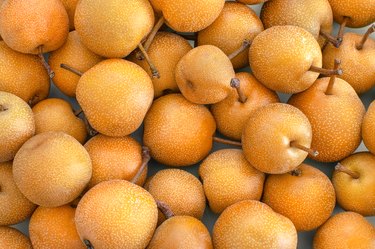
What's the difference between an apple and a pear? When you throw Asian pears into the mix, judging by shape is no longer an option. Most Asian pears are shaped like apples.
Yellow-green Asian pears even resemble some apples. Asian pears' unique taste and texture will always set them apart.
Tip
The skin on an Asian pear is definitely edible. Some varieties have thicker skins than the traditional, bell-shaped European pear, so whether to peel them before eating, or not, is up to you.
Video of the Day
Video of the Day
Enjoying Asian Pears
Asian pears have the crispness of apples, with a flavor similar to that of the "traditional" European pear. With that combination, it's no wonder they're often called apple pears. But while they taste similar to European pears, different Asian pear varieties can deliver flavor notes ranging from butterscotch or cinnamon.
Pears that have "russeted" skin are less tender, at least in patches. Russeting refers to browner, thicker skin. On Asian pears, the russeting may be characteristic of the entire surface, or just some parts. The skin is still edible, but may not be to everyone's taste. Asian pear skin is most similar to that of a European Bosc pear.
There are three main types of Asian pears, and several widely grown varieties within those broader categories. According to the University of California-Davis, the "pear-shaped" type will have either green or russet skin, depending on the cultivar. The second type is roundish and has bronze skin, which may be tougher. The third type is also round, but has yellow or green, tender skin.
Ask your grocer for advice and samples, and you're sure to come up with pears which you prefer. If you're stuck with a variety that's tougher-skinned than you'd like, peel and chop the Asian pears for use in a dinner salad or cooked dessert.
Crunch Into Some Fiber
While Asian pears tend to have thicker skins than their European counterparts, the trade-off is a higher fiber content. The American Council on Exercise's Nutrition section notes that a large Asian pear has about 10 grams of fiber, compared to the 7 grams a large European pear contains.
Dietary fiber is crucial to your health. Adults need an average of about 30 grams of fiber each day, according to the Mayo Clinic. With up to 10 grams of fiber, an Asian pear provides about one-third of the fiber you need for the day.
Along with keeping you "regular," dietary fiber is heart-healthy, stabilizes blood sugar and helps you feel fuller, which helps with weight regulation. Pears are high in the kind of dietary fiber known as soluble fiber. This type is especially prized for fighting high cholesterol and stabilizing glucose.
Asian Pears Deliver Other Nutrients
According to the U.S. Department of Agriculture's figures, a large Asian pear has 116 calories. It also contains 30 grams of carbohydrates and about 1.5 grams of protein, with no saturated fat.
Aside from their rich fiber content, Asian pears are also a good source of vitamin C and vitamin K. The fruit also delivers at least 5 percent of the potassium and magnesium your body needs for the day. In addition, Asian pears provide vitamin E, calcium and zinc.
So, nutritionally speaking, what's the difference between an apple and a pear? The Asian types of pear have about twice the fiber and protein as apples, according to USDA. They're also higher in most of the vitamins and minerals that both contain, although apples are slightly higher in vitamin E than Asian pears.
- Produce for Better Health Foundation: "Asian Pears"
- Washington State University: "Pear Varieties (Asian Pear Tab)"
- University of California Davis: "Asian Pears"
- American Heart Association: "Quinoa and Asian Pear Salad"
- American Council on Exercise: "Tropical Fruit in Spiced Syrup"
- American Council on Exercise: "5 Fiber Foods You Can't Live Without"
- Mayo Clinic: "Dietary Fiber - Essential for a Healthy Diet"
- USDA: "Nutrition Facts for Asian Pears"
- USDA: "Nutrition Facts for Apples"